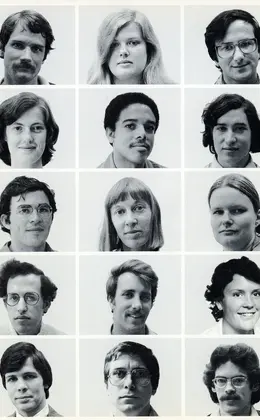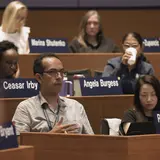
The Historian’s Notebook: The First SOMers
This edition of the Historian’s Notebook looks at the Charter Class, the first cohort of students to matriculate at Yale SOM.
The Historian’s Notebook: 50 Years of Business & Society is a blog series created in preparation for the 50th anniversary of Yale SOM in September 2026. The series is written by Yale SOM’s resident historian, Michelle Spinelli. Reach out if you have an idea for a blog post, memories or photos to share, or an inquiry about SOM history.
In the last installment of the Historian’s Notebook, we looked back at the opening of Yale SOM. And while these blog posts won’t typically flow chronologically, I thought it would make sense to offer a glimpse of the Charter Class—the “intrepid, highly qualified group of entrepreneurs” whom William Donaldson, the inaugural dean, welcomed on September 13, 1976.
In many ways, chance drew these risk-takers together. There was no proven recruitment strategy for a school whose intention was to be different. A New York Times interview with Donaldson piqued the curiosity of James Firestone ’78. Another incoming student, Pam Farr ’78, a former president of the Yale SOM Alumni Association, learned about the new venture through a copy of the Yale Alumni Magazine that a company intern had left around the office.
At the same time, the first applicants to SOM were nothing if not serious and deliberate. They chose to apply because their interests and values aligned with the multisectoral mission of Yale’s youngest graduate school—to train leaders to work in the public as well as private spheres.
In their application essays, many of the incoming students showed a particular eagerness to study the intersections of different organizational sectors. A branch loan officer saw the importance of understanding private banking in relation to federal and state laws, the Federal Reserve, and the Federal Trade Commission. An architect believed that a design education alone could not adequately prepare a person to work on publicly funded projects, particularly ones that required an understanding of urban planning and development.
Another applicant understood that a solid grounding in the management of both private and public organizations would help them become a better global leader. “The MPPM provides the best preparation for a management career related to Japan,” the student wrote, “where the distinction between public and private institutions has been blurred to a degree unique among modern industrialized states.”



In the end, 34 men and 16 women arrived at SOM that fall. They came with an average of four years of full-time work experience, with the public and private sectors equally represented, and they held undergraduate and graduate degrees in fields spanning from mathematics and law to metallurgy and the fine arts. Among them was a U.S. Army officer, a professor of Japanese history, a partner in a commodities trading firm with a doctorate from Oxford, a community activist, a legislative assistant, a public works administrator, and an actor and theater manager.
Once classes began, members of the Charter Class became very close. Several alumni expressed this sentiment in a 2016 video that anticipated SOM’s fifth decade. “It was a ‘we’re in this together’ kind of group,” recalled Farr.
And this wasn’t just a feeling of closeness: the first students had limited classroom space. “It was like you were in the third grade again,” said Cathy Lanier ’78. “You sat at a desk all day. The teachers came and went.”
That sense of unity in the Charter Class persists today. Lanier remarked, “If you could take any of the people in our class and put them here, I’d be delighted to see them and feel like I still knew a lot about them.”



